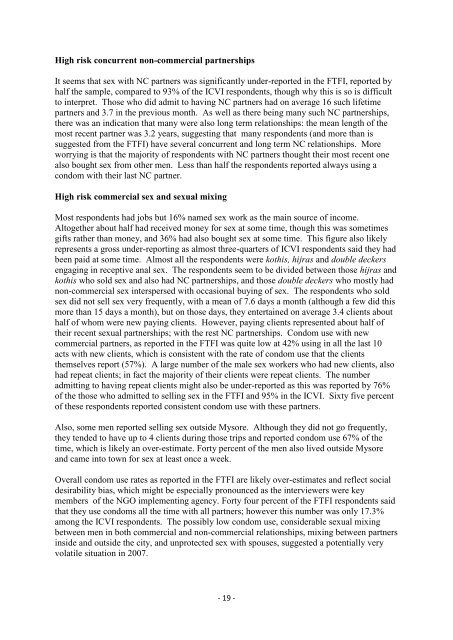sexual behaviour and hiv risk in men who - Karnataka Health ...
sexual behaviour and hiv risk in men who - Karnataka Health ...
sexual behaviour and hiv risk in men who - Karnataka Health ...
Create successful ePaper yourself
Turn your PDF publications into a flip-book with our unique Google optimized e-Paper software.
High <strong>risk</strong> concurrent non-commercial partnershipsIt seems that sex with NC partners was significantly under-reported <strong>in</strong> the FTFI, reported byhalf the sample, compared to 93% of the ICVI respondents, though why this is so is difficultto <strong>in</strong>terpret. Those <strong>who</strong> did admit to hav<strong>in</strong>g NC partners had on average 16 such lifetimepartners <strong>and</strong> 3.7 <strong>in</strong> the previous month. As well as there be<strong>in</strong>g many such NC partnerships,there was an <strong>in</strong>dication that many were also long term relationships: the mean length of themost recent partner was 3.2 years, suggest<strong>in</strong>g that many respondents (<strong>and</strong> more than issuggested from the FTFI) have several concurrent <strong>and</strong> long term NC relationships. Moreworry<strong>in</strong>g is that the majority of respondents with NC partners thought their most recent onealso bought sex from other <strong>men</strong>. Less than half the respondents reported always us<strong>in</strong>g acondom with their last NC partner.High <strong>risk</strong> commercial sex <strong>and</strong> <strong>sexual</strong> mix<strong>in</strong>gMost respondents had jobs but 16% named sex work as the ma<strong>in</strong> source of <strong>in</strong>come.Altogether about half had received money for sex at some time, though this was sometimesgifts rather than money, <strong>and</strong> 36% had also bought sex at some time. This figure also likelyrepresents a gross under-report<strong>in</strong>g as almost three-quarters of ICVI respondents said they hadbeen paid at some time. Almost all the respondents were kothis, hijras <strong>and</strong> double deckersengag<strong>in</strong>g <strong>in</strong> receptive anal sex. The respondents seem to be divided between those hijras <strong>and</strong>kothis <strong>who</strong> sold sex <strong>and</strong> also had NC partnerships, <strong>and</strong> those double deckers <strong>who</strong> mostly hadnon-commercial sex <strong>in</strong>terspersed with occasional buy<strong>in</strong>g of sex. The respondents <strong>who</strong> soldsex did not sell sex very frequently, with a mean of 7.6 days a month (although a few did thismore than 15 days a month), but on those days, they enterta<strong>in</strong>ed on average 3.4 clients abouthalf of <strong>who</strong>m were new pay<strong>in</strong>g clients. However, pay<strong>in</strong>g clients represented about half oftheir recent <strong>sexual</strong> partnerships; with the rest NC partnerships. Condom use with newcommercial partners, as reported <strong>in</strong> the FTFI was quite low at 42% us<strong>in</strong>g <strong>in</strong> all the last 10acts with new clients, which is consistent with the rate of condom use that the clientsthemselves report (57%). A large number of the male sex workers <strong>who</strong> had new clients, alsohad repeat clients; <strong>in</strong> fact the majority of their clients were repeat clients. The numberadmitt<strong>in</strong>g to hav<strong>in</strong>g repeat clients might also be under-reported as this was reported by 76%of the those <strong>who</strong> admitted to sell<strong>in</strong>g sex <strong>in</strong> the FTFI <strong>and</strong> 95% <strong>in</strong> the ICVI. Sixty five percentof these respondents reported consistent condom use with these partners.Also, some <strong>men</strong> reported sell<strong>in</strong>g sex outside Mysore. Although they did not go frequently,they tended to have up to 4 clients dur<strong>in</strong>g those trips <strong>and</strong> reported condom use 67% of thetime, which is likely an over-estimate. Forty percent of the <strong>men</strong> also lived outside Mysore<strong>and</strong> came <strong>in</strong>to town for sex at least once a week.Overall condom use rates as reported <strong>in</strong> the FTFI are likely over-estimates <strong>and</strong> reflect socialdesirability bias, which might be especially pronounced as the <strong>in</strong>terviewers were keymembers of the NGO imple<strong>men</strong>t<strong>in</strong>g agency. Forty four percent of the FTFI respondents saidthat they use condoms all the time with all partners; however this number was only 17.3%among the ICVI respondents. The possibly low condom use, considerable <strong>sexual</strong> mix<strong>in</strong>gbetween <strong>men</strong> <strong>in</strong> both commercial <strong>and</strong> non-commercial relationships, mix<strong>in</strong>g between partners<strong>in</strong>side <strong>and</strong> outside the city, <strong>and</strong> unprotected sex with spouses, suggested a potentially veryvolatile situation <strong>in</strong> 2007.- 19 -















